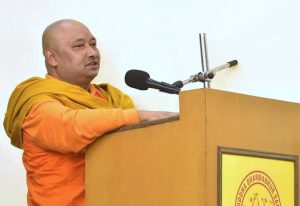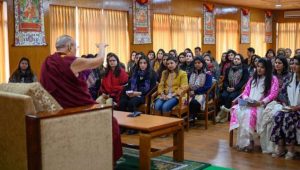
When Buddhist projects use the platitude “world peace” for the purpose of raising money or promoting a performance, they veer dangerously into territory established in Asian traditional dance by the problematic 20th century Trinidadian dance activist Dai Ailian, who worked with the Chinese government to “improve and uplift” Tibetan and other folk dances to “make them palatable” for an international audience.
But nothing is uplifted by the systemic “improvement” of a traditional art to appease some imaginary global audience that—apparently—is unable to appreciate a folk dance for what it is. In the case of China and Dai Ailian “uplifting” Tibetan dances (thereby appropriating them), it meant diluting them of any cultural identity or meaning; divesting any religious implication, abandoning the actual structure of the dance in order to “face front” on a proscenium stage and wearing flashy, sequined outfits. It also meant rewriting the history of the dance—which is in itself already an historical account—to become something untrue. This is the basic danger of the strategic “improvement” of ancient arts.
Over the past few decades, I‘ve witnessed some egregious Buddhist events where dance and music and “world peace” were on offer. The blurring of religion, tourism, raising money (especially in the West), and an attitude toward people as gullible to platitudes, pretty much ensures the performance won’t be good on one or many levels. So my initial excitement at the scheduled performance of a new Noh play in September this year, was quickly dulled by the promotion material, which relies on “peaceful coexistence” to explain and present an historical esoteric phenomenon: the eighth century Japanese monk Kukai, who learned tantric Buddhism in China and brought it to Japan, eventually establishing a meditation complex on Mount Koya for dedicated meditation training.
Kukai is not well known in the West. He is perhaps better known by his posthumous name, Kobo Daishi, an honorific title appropriate to the legendary status of this capable and skillful man. Kukai was a monk who traveled to gain knowledge, even traveling to gain the benefit of traveling itself: an 88-temple pilgrimage on the isle of Shikoku. Kukai’s mythical transformation into Kobo Daishi has taken on proportions relative to the spiritual impact he had on Japan, attributing many miracles to him, as well as the founding of Shingon esoteric Buddhism. What is true, and very real, is the tradition of esoteric Buddhist practice, based on a two-mandala ritual embracing the fundamental essence of life and world: the Diamond Realm Mandala and its counterpart, the Womb Mandala. These are variant practices based on the ancient Indian Vajradhatu and Mahavairocana cults of meditation practice. However, due to the rigor of transmission, and practice of secrecy on Mount Koya, these rituals are maintained with more authenticity in Japan, than in India, China, or Tibet. This power and continuity are very real. The practice of retracing Kukai’s pilgrimage route in Shikoku has also never ceased, and is practiced with devotion still today by mountain ascetics and lay Buddhists.
In fact, Mount Koya is considered something of an earthly paradise, ideal for spiritual refinement. Today, visitors can stay on Mount Koya, in the temple complex grounds, in a traditional monastery room, joining in with certain monastic prayers and rituals, and eating the vegetarian monastic cuisine. You can go to Mount Koya and taste the lifestyle and meditation practices that Kukai championed. This is all wonderful. Although “world peace” has nothing to do with any of it. Your personal spiritual growth is what is emphasized.
According to the promoter, “Kukai’s philosophy, expressed through the intricate symbolism of rituals, mandalas, and meditation, champions the ideals of peaceful coexistence over exclusion.” This is hogwash. Tantric Buddhism is esoteric: exclusionary by design, reserved for initiates, committed to secrecy. Shingon Buddhism is about “peaceful coexistence over exclusion”? Such a statement is modern promo-speak, not accurate, misleading, and platitudinous.
The notion of “world peace” is a modern altruistic concept that evolved with the development of global awareness and the increasing interconnectedness of nations. Since then, it has degenerated into what amounts basically to marketing copy. German philosopher Immauel Kant’s 1795 essay “Perpetual Peace: A Philosophical Sketch” is the first document to envision a perpetual peace among nations. While earlier times and religions saw localized or regional concepts of peace, it wasn’t until the Enlightenment and the subsequent global conflicts of the 20th century that the idea of peace on a worldwide scale took on significant importance. The establishment of the United Nations after World War Two was in part based on the concept of the possibility of lasting geopolitical peace.
This evolution reflects a growing recognition of the interconnected nature of human societies and the need for cooperative efforts to ensure lasting peace. Buddhism’s commitment to non-violence cannot be construed as advocating world peace. In the eighth and ninth centuries, when Kukai lived, the notion of the world, and indeed the worlds, in which we live was varied and largely imagined. Maps of the world have long existed, since ancient times, even as the notion of the world—flat, discreet, and contained—evolved.
All to say, Kukai’s teachings for tantric meditation techniques had nothing to do with world peace. Mandalas, mudra, mantra, and their development as meditation tools for consciousness transformation, have nothing to do with world peace. And there’s the rub.
Why would modern promoters advertise a new Noh play—in and of itself rare enough—based on the story of Kukai and his teachings, using world peace as the hook to bring in the punters? The real crime is not the wanton inaccuracies it unleashes, it is the replacing of something fascinating and multifaceted with something boring and platitudinous. There must be a belief that world peace is a good advertising ploy, and indeed some Buddhist rituals today are dedicated to world peace quite sincerely.
The new play, written and produced by promoter Kasai Kenichi, is about Kukai, the Buddhist patriarch who introduced esoteric tantric Buddhism and provided a monastery and school on Mount Koya. Kasai-san has dedicated this performance to the 20th anniversary of Mount Koya being designated a World Heritage Site by UNESCO. This is most odd. Here is a direct connection to purveyors of world peace, the United Nations.
It would require a separate article to treat all the problems with World Heritage designations, the mass tourism and banal understandings that they invite, and the generally arbitrary way that the designation is “awarded.” The designation has been directly linked to the failing fortunes of a number of now-overrun sites. UNESCO’s record with intangible cultures is worse. All of this bizarre reframing falls under the umbrella of world-peace thinking. What’s not to like? Tantric Buddhism! World Peace! Thumbs Up! Kukai! Yeah! Him and his mandalas—world peace all the way! Buddhism’s modern rationale in the world: world heritage and world peace.
I’d contend that the occasion of a new Noh play is reason enough to attend. I don’t think Noh needs improving, or reframing. Taking Kukai as a subject is also reason enough to attend. His story doesn’t need improving either. Just seeing what this unusual salute to UNESCO turns out to be is reason enough to attend. On 15 September 2024, Mount Koya, at 6 p.m. Tickets are 12,000 yen each. Famous Noh actors are listed as performing, although these are not all confirmed. The chance to see one of the old great masters is reason enough to attend. One thing I really like about the La Scala opera in Milan is the attitude of their audience. If a show is a big success, it is hard to get a ticket. If a show is just impossibly bad, an inconceivable failure, it is impossible to get a ticket. World Peace Kukai Noh? I would get a ticket as quickly as I could, hope for the best, and see what happens.
See more
Related features from BDG
Anti-War Performance, Part One
Anti-War Performance, Part Two













